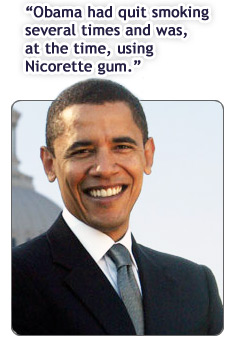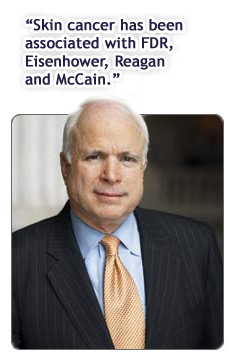 When Republican presidential nominee John McCain allowed reporters to view 1,173 pages of his medical records earlier this year, the media documented every detail from the condition of his rear end (described by his oncologist, following a colonoscopy, as "unremarkable except for some very light tan freckling") to his multiple surgeries for skin cancer.
 The Democratic nominee, Barrack Obama, meanwhile, received far less attention that same month, when his primary care doctor of 21 years said Obama was "in excellent health" but had quit smoking several times and was, at the time, using Nicorette gum.
With a new presidency on the horizon, we thought it would be fun to look back at some of the health issues of past presidents.
Zachary Taylor (President: 1849-1850)History doesn’t concretely reveal what caused the death of Zachary Taylor, the 12th president of the United States. In the end, poor health may have had as much to do with the death of Taylor, who died after eating cherries and milk on the Fourth of July. Eating bad food may just have been the final unrecoverable blow for a man who had suffered from two bouts of severe diarrhea and fever during the first year of his presidency. True, he had survived malaria and cholera, yellow fever, and dysentery earlier in his life, but whatever struck Taylor 16 months into his presidency was more than he could handle. He died in the White House on July 9, 1850, at the age of 65.
Abraham Lincoln (President: 1861-1865)A sexually transmitted disease probably wouldn’t be the main health concern that comes to mind when most Americans think about the life of Abraham Lincoln, but multiple sources suggest Honest Abe suffered symptoms of syphilis.
An STD isn’t the only ailment that plagued Lincoln. He’s thought to have had Marfan syndrome -- a connective tissue disorder -- and to have contracted smallpox shortly after the Gettysburg address in 1863. At least one doctor suggests that Lincoln suffered from multiple endocrine neoplasia II -- a rare, inherited condition in which the thyroid, adrenal, and parathyroid glands can develop cancer.
Franklin Delano Roosevelt (President: 1933-1945)Early in his fourth term, in April 1945, President Franklin Delano Roosevelt collapsed from a cerebral hemorrhage and died a few hours later. FDR was likely not in good health in the months preceding his death, though no one can say what his medical condition was for certain: His medical records, which were kept in a safe at Bethesda Naval Hospital, in Maryland, disappeared after his death.
What we know is that FDR came into office paralyzed to the hips from polio. In 1937, at 55, he was diagnosed with high blood pressure. By 1941, doctors said Roosevelt had severe iron deficiency anemia. In late November 1943, he suffered an "acute indigestive attack" serious enough to spawn ill-founded rumors of poisoning, but by January his doctors thought it had been a case of the flu. It may, argues one researcher, have been cholecystitis -- an inflammation of the gallbladder -- or an obstruction in a blood vessel.
In March 1944, a cardiologist discovered Roosevelt had heart disease. A year later he was dead. His sudden death was a shock to the nation, and ushered in the presidency of Harry S. Truman.
Cancer in the White HouseCancer has been a partner to many presidencies. During his second presidency, Grover Cleveland (1895-1889, 1893-1897) discovered a rough patch on the roof of his mouth, which was diagnosed as throat cancer. A few weeks later, without informing the public, the press, or his Cabinet, Cleveland had surgery on his yacht.
Skin cancer, the reason for several surgeries on candidate McCain, has also found a regular home in the White House. FDR is suspected of having had melanoma on his face, and the blackish nodule removed from Dwight Eisenhower’s midsection was thought to be melanoma, though it appears to have actually been a noncancerous tumor.
Ronald Reagan (1981-1989) had several well-published bouts with cancer: In 1984 and 1985 benign polyps were found in his colon. After the second examination, doctors removed a villous adenoma, a tumor that can become cancerous. A few years later, doctors removed a small basal cell carcinoma (skin cancer) from Reagan’s nose. William Clinton (1993-2001) also had a precancerous growth removed from the side of his nose in 1996, and a small basal cell carcinoma removed from his back in 2001, just before his second term ended.
Heart troubleWhether it’s job stress, genes, age, or bad health habits, heart disease is common among presidents. For example, prior to negotiating the end of World War II at Yalta, FDR is known to have had high blood pressure, heart failure, and evidence of cerebral vascular disease.
Meanwhile, during his term in office, Warren G. Harding (1921-1923), the 29th president, seems to have had heart disease. By 1922, a year into his term, he was suffering from exhaustion and chest pains. Then, on August 2, 1923, Harding died suddenly in a hotel room in San Francisco. Though his widow refused to allow an autopsy, many historians speculate he had a heart attack.
 Many other presidents have shown symptoms of heart disease, though not all of them can be confirmed. In May 1991, while jogging at Camp David, President George H. W. Bush (1989-1993) developed an irregular heartbeat, caused by either Graves disease or hyperthyroidism.
Presidential successionThere have been a few rare times a president’s health has affected his ability to lead. When the 9th president, William H. Harrison (1841), contracted pneumonia during his inauguration and died a month into his presidency, he left John Tyler (1841-1845), his Vice President, to run the White House. Tyler was soon expelled from the Whig party -- while in office. In the end, Harrison’s death lead to the demise of the party.
Woodrow Wilson (1913-1921) spent nearly the entire last year-and-a-half of his presidency incapacitated after suffering a stroke in 1919. Wilson was no stranger to illness. In 1918, as American troops were fighting in World War I, the president had a hushed operation for a breathing problem. The operation was likely performed to remove polyps from inside the president’s nose, yet only the doctor, the president’s wife, a nurse, and a White House usher knew of the surgery.
Then came the stroke. In October 1919, Wilson collapsed after a national tour. He went into seclusion, and the public was largely in the dark about his condition for the rest of his presidency. Yet the Constitution was unclear about the removal of an incapacitated president, and Wilson remained in power, while his vice president, Thomas Marshall, refused to replace him. During this time, 28 bills became law without the president’s signature.
Wilson wasn’t the first president to live out his presidency in name only. In fact, James A. Garfield (1881), who was shot 6 months into his presidency, hovered near death for 80 days before dying, yet he remained the commander-in-chief the entire time.
While the vice president’s role as presidential replacement was largely unofficial, it was becoming a greater concern for leaders during the tense times of the Cold War. Dwight Eisenhower (1953-1961) improvised an arrangement with his vice president -- Richard Nixon -- for temporary succession, to be conferred by a letter from the president, should he become disabled. Eisenhower’s concern was not without merit. In September 1955 he suffered a heart attack; the following June he had an operation for an inflammation of the small intestines. In November 1957, after being re-elected to a second term, he had a stroke. And, yet, he continued to serve out his presidency.
The procedure for what to do when a president is disabled and can’t perform his duties didn’t finally become concrete until the Twenty-fifth Amendment was adopted in 1967, clearly defining the process for succession so that, if necessary, an acting president can lead the nation. Most recently, the Amendment has been used twice during the presidency of George W. Bush, conferring the title of Acting President to Dick Cheney for about two hours each time, in 2002 and 2007, while Bush underwent colonoscopy.
|